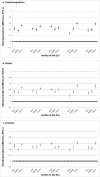The association between physical inactivity and obesity is modified by five domains of environmental quality in U.S. adults: A cross-sectional study
- PMID: 30161196
- PMCID: PMC6117021
- DOI: 10.1371/journal.pone.0203301
The association between physical inactivity and obesity is modified by five domains of environmental quality in U.S. adults: A cross-sectional study
Abstract
Physical inactivity is a primary contributor to the obesity epidemic, but may be promoted or hindered by environmental factors. To examine how cumulative environmental quality may modify the inactivity-obesity relationship, we conducted a cross-sectional study by linking county-level Behavioral Risk Factor Surveillance System data with the Environmental Quality Index (EQI), a composite measure of five environmental domains (air, water, land, built, sociodemographic) across all U.S. counties. We estimated the county-level association (N = 3,137 counties) between 2009 age-adjusted leisure-time physical inactivity (LTPIA) and 2010 age-adjusted obesity from BRFSS across EQI tertiles using multi-level linear regression, with a random intercept for state, adjusted for percent minority and rural-urban status. We modelled overall and sex-specific estimates, reporting prevalence differences (PD) and 95% confidence intervals (CI). In the overall population, the PD increased from best (PD = 0.341 (95% CI: 0.287, 0.396)) to worst (PD = 0.645 (95% CI: 0.599, 0.690)) EQI tertile. We observed similar trends in males from best (PD = 0.244 (95% CI: 0.194, 0.294)) to worst (PD = 0.601 (95% CI: 0.556, 0.647)) quality environments, and in females from best (PD = 0.446 (95% CI: 0.385, 0.507)) to worst (PD = 0.655 (95% CI: 0.607, 0.703)). We found that poor environmental quality exacerbates the LTPIA-obesity relationship. Efforts to improve obesity through LTPIA may benefit from considering this relationship.
Conflict of interest statement
The authors have declared that no competing interests exist.
Figures


Similar articles
-
Geographical Variations in the Environmental Determinants of Physical Inactivity among U.S. Adults.Int J Environ Res Public Health. 2017 Oct 31;14(11):1326. doi: 10.3390/ijerph14111326. Int J Environ Res Public Health. 2017. PMID: 29088093 Free PMC article.
-
Associations between environmental quality and adult asthma prevalence in medical claims data.Environ Res. 2018 Oct;166:529-536. doi: 10.1016/j.envres.2018.06.020. Epub 2018 Jun 27. Environ Res. 2018. PMID: 29957506 Free PMC article.
-
The associations between environmental quality and preterm birth in the United States, 2000-2005: a cross-sectional analysis.Environ Health. 2015 Jun 9;14:50. doi: 10.1186/s12940-015-0038-3. Environ Health. 2015. PMID: 26051702 Free PMC article.
-
Physical Inactivity and Obesity in the United States Through the Lens of the 2012 and 2016 Presidential Elections.Curr Probl Cardiol. 2024 Jan;49(1 Pt B):102068. doi: 10.1016/j.cpcardiol.2023.102068. Epub 2023 Sep 7. Curr Probl Cardiol. 2024. PMID: 37689376 Review.
-
Physical Inactivity and Obesity in the United States: At the Intersection of Politics, Socioeconomics, Race, and Culture.Curr Probl Cardiol. 2023 Dec;48(12):102007. doi: 10.1016/j.cpcardiol.2023.102007. Epub 2023 Aug 4. Curr Probl Cardiol. 2023. PMID: 37544627 Review.
Cited by
-
Are people in the bush really physically active? A systematic review and meta-analysis of physical activity and sedentary behaviour in rural Australians populations.J Glob Health. 2020 Jun;10(1):010410. doi: 10.7189/jogh.10.010410. J Glob Health. 2020. PMID: 32373329 Free PMC article.
-
Influence of Lifestyle Changes on Cardiovascular Diseases in Saudi Arabia: A Systematic Literature Review.Cureus. 2023 Jun 7;15(6):e40075. doi: 10.7759/cureus.40075. eCollection 2023 Jun. Cureus. 2023. PMID: 37425506 Free PMC article. Review.
-
Prevalence and factors associated with overweight and obesity in selected health areas in a rural health district in Cameroon: a cross-sectional analysis.BMC Public Health. 2021 Mar 10;21(1):475. doi: 10.1186/s12889-021-10403-w. BMC Public Health. 2021. PMID: 33691650 Free PMC article.
-
Air quality and obesity at older ages in China: The role of duration, severity and pollutants.PLoS One. 2019 Dec 11;14(12):e0226279. doi: 10.1371/journal.pone.0226279. eCollection 2019. PLoS One. 2019. PMID: 31826013 Free PMC article.
-
Four Weeks of Detraining Induced by COVID-19 Reverse Cardiac Improvements from Eight Weeks of Fitness-Dance Training in Older Adults with Mild Cognitive Impairment.Int J Environ Res Public Health. 2021 May 31;18(11):5930. doi: 10.3390/ijerph18115930. Int J Environ Res Public Health. 2021. PMID: 34073051 Free PMC article.
References
Publication types
MeSH terms
Grants and funding
LinkOut - more resources
Full Text Sources
Other Literature Sources
Medical

